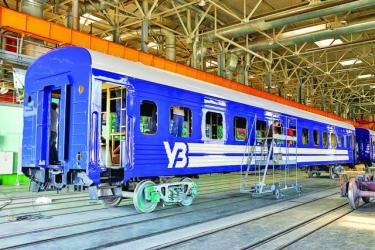Крюківський вагонобудівний завод виготовить 100 вагонів для Укрзалізниці
На Крюківському вагонобудівному заводі в Кременчуці розпочали реалізовувати проект на постачання 100 нових пасажирський вагонів для Укрзалізниці. Нещодавно підприємство отримало майже 1 мільярд гривень авансу.
«Тривалий час завод не отримував великого державного замовлення. Нарешті є контракт на виробництво 100 нових спальних вагонів. Терміни, які оговорені в угоді між заводом та Укрзалізницею, будуть витримані. Етап виробництва хотілося б пришвидшити, і, ми впевнені, підприємство підтримає таку ініціативу», — повідомив міністр інфраструктури України Олександр Кубраков під час робочого візиту на КВБЗ.
«Крюківський вагонобудівний завод активно виконує замовлення Укрзалізниці. Уже готові два вагони, які будуть представлені на виставці в Києві під час відзначення Дня Незалежності України. Крім того, 25 кузовів уже розкроєні, близько 18 вагонів зварені, 8 — пофарбовані, а також зібрані 30 візків ходової», — зазначив голова Полтавської облдержадміністрації Олег Синєгубов.
Він додав, що загалом Укрзалізниця та КВБЗ уклали контракт на понад 3 мільярди гривень. «Це одне з найбільших держзамовлень в історії КВБЗ та вагомий внесок в промисловість Полтавщини. На підприємстві працюють понад 4 000 працівників. Після отримання авансу оголошено про відкриття вакансій, щоб завод збільшував свої потужності. Це саме та підтримка вітчизняного виробництва, про яку неодноразово зазначав Президент України», — зауважив Олег Синєгубов. Раніше на КВБЗ неодноразово приїжджали перші особи й обіцяли підтримку та фінансування, але факт залишається фактом: уперше за 20 років велике державне замовлення підприємство отримало саме завдяки Президенту Володимиру Зеленському та нинішнім командам Кабміну, Міністерства інфраструктури й облдержадміністрації, повідомляє прес-служба Полтавської облдержадміністрації.
У найближчі місяці перші вагони будуть поставлені Укрзалізниці, і пасажири зможуть ними скористатися. Загалом цього року, резюмував Олександр Кубраков, на розвиток залізниці України в бюджеті передбачено 4 мільярди гривень. Із них 3 мільярди — на придбання нових пасажирських вагонів, 1 мільярд — на інфраструктурні проекти, які спрямовані на покращення пасажирського сполучення.




Додати новий коментар
JamesBig
12.07 2025 - 5:21
Посилання
The bow of a US Navy cruiser
JamesCap
12.07 2025 - 5:31
Посилання
Unity and BrightBuilt factory
Darricknum
12.07 2025 - 5:35
Посилання
Today was supposed to be the
Armandonof
12.07 2025 - 10:15
Посилання
The bow of a US Navy cruiser
Thomasdow
12.07 2025 - 10:21
Посилання
Today was supposed to be the
Clintonlacle
12.07 2025 - 10:30
Посилання
Unity and BrightBuilt factory
Michaelvom
12.07 2025 - 14:42
Посилання
The bow of a US Navy cruiser
Everettalafe
12.07 2025 - 14:44
Посилання
Today was supposed to be the
Jameshex
12.07 2025 - 15:02
Посилання
Unity and BrightBuilt factory
Brianvef
12.07 2025 - 18:56
Посилання
High costs are still a big
RobertBoath
12.07 2025 - 23:47
Посилання
High costs are still a big
NathanRap
13.07 2025 - 4:23
Посилання
High costs are still a big
Josephdal
16.07 2025 - 18:36
Посилання
The latest Barbie slays in a
Floydhus
16.07 2025 - 20:06
Посилання
Job losses
Georgecrida
16.07 2025 - 21:37
Посилання
Rescuers are hailing as a
BarryIntep
17.07 2025 - 6:52
Посилання
Job losses
Victormon
17.07 2025 - 8:10
Посилання
Rescuers are hailing as a
Georgebem
17.07 2025 - 15:08
Посилання
Rescuers are hailing as a
online casino i...
18.07 2025 - 1:49
Посилання
Посетите наше <a href=https:/
MichaelLargo
18.07 2025 - 6:11
Посилання
Строительство домов — это
JasonTourl
19.07 2025 - 20:01
Посилання
The levies are also likely to
casino games fo...
19.07 2025 - 20:12
Посилання
Посетите наше <a href=https:/
Walterdib
25.07 2025 - 8:52
Посилання
<p dir="ltr">В Приморском
CoreyPauts
25.07 2025 - 13:05
Посилання
Indian and Chinese travelers
RichardSlubs
27.07 2025 - 11:38
Посилання
BS2Best Ссылка — Где Найти
Clintonlacle
28.07 2025 - 22:25
Посилання
Unity and BrightBuilt factory
ScottMom
29.07 2025 - 7:15
Посилання
What struck Scott Bennett
Richardcon
29.07 2025 - 10:03
Посилання
It all started back in March,
DanielNaike
29.07 2025 - 12:45
Посилання
It all started back in March,
AnthonyHeicy
29.07 2025 - 13:33
Посилання
What struck Scott Bennett
Keithmaype
29.07 2025 - 17:22
Посилання
It all started back in March,
bk8-79
30.07 2025 - 17:38
Посилання
Don’t miss important posts –
pusulabet-795
1.08 2025 - 15:31
Посилання
Guncel duyurular ve icerikler
pusulabet-925
1.08 2025 - 21:13
Посилання
<a href=https://www.facebook
188bet-695
2.08 2025 - 12:29
Посилання
G?p g? nh?ng thanh vien th?c
789bet-715
2.08 2025 - 13:50
Посилання
T?t c? n?i dung chinh xac v?
hi88-36
2.08 2025 - 15:45
Посилання
Day la ngu?n thong tin chinh
shbet-329
2.08 2025 - 17:06
Посилання
Theo doi cac thong bao quan
f8bet-223
2.08 2025 - 18:26
Посилання
Kham pha cac chia s? ch?t lu
new88-239
2.08 2025 - 20:15
Посилання
C?p nh?t thong bao m?i nh?t t
33win-984
2.08 2025 - 21:55
Посилання
Nh?n thong bao t? ngu?n chinh
bk8-467
2.08 2025 - 23:54
Посилання
Kham pha n?i dung ch?t lu?ng
kubet-461
3.08 2025 - 1:46
Посилання
C?p nh?t thong tin m?i nh?t
tigrinhoRit
3.08 2025 - 13:22
Посилання
O portal oficial do <a href
tigrinhoRit
3.08 2025 - 14:52
Посилання
Descubra tudo sobre o <a href
tigrinhoRit
3.08 2025 - 16:26
Посилання
No <a href=https://tigrinho-1
tigrinhoRit
3.08 2025 - 18:05
Посилання
Acesse o site oficial do <a
tigrinhoRit
3.08 2025 - 19:42
Посилання
Acesse o site oficial <a href
tigrinhoRit
3.08 2025 - 21:29
Посилання
Entre para a comunidade
tigrinhoRit
3.08 2025 - 22:52
Посилання
Acesse o site oficial <a href
Сторінки